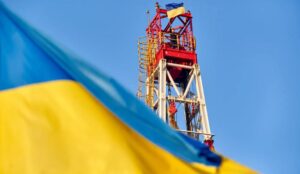
The Ministry of Energy of Ukraine announced a competitive selection of candidates for three positions of independent members of the supervisory board of Ukrenergo and instructed Ukrenergo to engage a professional consultant on personnel selection.
“The government remains fully committed to ensuring the independence, integrity and compliance with the highest professional standards of the new supervisory board. The selection of all members of the board – four independent and three representatives of the state – is to be completed by December 9,” the ministry said on Friday evening.
As reported, EU Ambassador to Ukraine Katarína Mathernová, regional heads of the European Bank for Reconstruction and Development (EBRD) and the International Finance Corporation (IFC), and the business ombudsman in early September called for stopping the dismissal of the company’s head Volodymyr Kudrytsky until the election of the seventh member of the board.
However, Kudrytsky was dismissed, after which the independent members of the Ukrenergo supervisory board, former ENTSO-E Presidents Daniel Dobbeni and Peder Andreasen, called the dismissal politically motivated and decided to leave the supervisory board early.
In addition, the G7 ambassadors emphasized the importance of quickly organizing a selection procedure according to the standards of the Organization for Economic Cooperation and Development (OECD) for “competent and professional independent experts” to the Ukrenergo supervisory board.

In Ukraine, only 471 thousand hectares are engaged in organic production, they need to increase, because the country keeps the course on deep processing, said the Minister of Agrarian Policy and Food Vitaly Koval at the conference dedicated to the organic market of Ukraine and its prospects.
“Regarding the first: organics is the closest to the settlement of all EU legislative processes. And if we are now among the top five in the supply of organic products to Europe, our task is to become the first. We have the space, the desire and the experience that our people have,” the press service of the Ministry of Agrarian Policy and Food quoted him as saying.
Koval emphasized the importance of exporting finished products, not raw materials. At the same time, they should meet the EU requirements.

After hydraulic fracturing, Ukrgasvydobuvannya JSC (UGV) has increased the flow rate at one of its wells fivefold to more than 100 thousand cubic meters of gas per day, the company’s press service reports.
According to the company, from November 2023 to August 2024, the well operated with a gradual decrease in flow rate from 29 thousand cubic meters to 18 thousand cubic meters of gas per day.
The decision to workover the well was made after calculating the well’s potential and collecting geological and technical information. The well was fractured within 18 days.
As reported, in January-August 2024, UGV increased commercial gas production by 7.2% compared to the same period last year – up to 9.26 bcm. During this period, UGV completed drilling of 62 wells, of which 52 were put into production. Of these, 23 have an initial daily flow rate of more than 100 thousand cubic meters.
In 2023, the company produced 13.224 bcm of commercial gas, which is 0.679 bcm more than in 2022. “In 2023, Ukrgasvydobuvannya launched 86 new wells, 24 of which had an initial flow rate of more than 100 thousand cubic meters.
Naftogaz of Ukraine owns 100% of Ukrgasvydobuvannya shares.

State-owned Oschadbank (Kyiv) and one of the largest grain market operators in Ukraine, JV Nibulon LLC, have agreed on a series of new loan agreements to replenish working capital, which refinance the company’s investments totaling $20.3 million, the first part of this loan program for $13 million has already been signed, the bank’s press service reports.
According to the report, Nibulon will use the funds to restore working capital after investing in the construction of a new transshipment terminal on the Danube. The Bessarabian branch began operations in 2022 and became the main route for exporting agricultural products, which was crucial in the context of the aggressor’s blockade of Ukrainian seaports in previous periods.
“The replenishment of working capital guarantees Nibulon’s ability to fully support the procurement campaign for the 2024/25 season and support the Ukrainian farmer in times of war,” the bank said, adding that after heavy losses and a difficult return to stability, the company was able to gain momentum and develop an ecosystem that will ensure sustainable food security.
“Nibulon has been a long-standing and reliable partner for us for over 6 years. It is one of the pillars of the country’s food potential, including exports. To date, the company’s total loan portfolio in Oschad is already almost UAH 2 billion. Given that Oschadbank has a high level of liquidity, we are ready to continue financial support for Nibulon in all its initiatives to restore its leadership positions in global markets lost due to the full-scale war,” said Yuriy Katsiyon, Deputy Chairman of the Board of Oschadbank in charge of corporate business, during the signing of the agreement.
The agroholding noted that the support of the real economy by state-owned banks is evidence of the government’s consistent adaptation of its policy to the conditions of a full-scale war and its real focus on helping businesses.
“We see changes. We see a targeted state policy of supporting domestic business in action. This is a direct recognition of the critical role of strategic enterprises for the further development of Ukraine and a guarantee of our successful future,” said Andriy Vadatursky, CEO of Nibulon. Andriy Vadatursky, CEO of Nibulon.
“We are grateful to Oschadbank for its systematic and consistent support of us, representatives of companies in the sector that ensures the country’s food security. At the very beginning of the full-scale war, Oschadbank provided Nibulon with additional funding for the 2022/2023 sowing campaign to prevent a food crisis that the aggressor was trying to create. In 2023, Oschadbank was one of the first to restructure Nibulon’s pre-war loan to support the company, which suffered losses due to the destruction of infrastructure during the hostilities, the blocking of sea routes from the port of Mykolaiv, and the forced reorientation to other logistics routes. And now we have new funding that we will use for the procurement campaign to support small and medium-sized agricultural producers,” said Vitalina Marchenko, Head of Nibulon’s Banking Department.
As reported earlier, Nibulon Group has more than 25 Ukrainian and foreign creditors, with the vast majority of whom have already signed restructuring agreements.
Nibulon JV LLC was established in 1991. Prior to the Russian military invasion, the grain trader had 27 transshipment terminals and crop reception complexes, capacity to store 2.25 million tons of agricultural products at a time, a fleet of 83 vessels (including 23 tugs), and owned the Mykolaiv Shipyard.
“Before the war, Nibulon cultivated 82 thousand hectares of land in 12 regions of Ukraine and exported agricultural products to more than 70 countries. In 2021, the grain trader exported the highest ever 5.64 million tons of agricultural products, reaching record volumes of supplies to foreign markets in August – 0.7 million tons, in the fourth quarter – 1.88 million tons, and in the second half of the year – 3.71 million tons.
Nibulon’s losses due to Russia’s full-scale military invasion in 2022 exceeded $416 million.
Currently, the grain trader is operating at 32% of capacity, has created a special unit to clear agricultural land of mines, and has been forced to move its headquarters from Mykolaiv to Kyiv.
According to the National Bank of Ukraine (NBU), as of July 1, 2024, Oschadbank ranked 2nd (UAH 435.06 billion) in terms of total assets among 62 banks in the country. Last year, the financial institution’s net profit amounted to UAH 5.98 billion.

The Antimonopoly Committee of Ukraine (AMCU) has fined a number of companies, including enterprises belonging to the Kernel and Continental Farmers Group agricultural holdings, for purchasing assets without obtaining the appropriate permit from the agency, the agency’s press service reports.
According to the report, Poltava-Zerno LLC, a part of Kernel, was fined UAH 170 thousand for violating the legislation on protection of economic competition under clause 12 of Article 50 of the Law “On Protection of Economic Competition” by acquiring assets consisting of movable and immovable property and forming a single property complex without obtaining the necessary permit from the AMCU.
For the same reason, a fine of UAH 3.3 million was imposed on Mriya Farming Karpaty LLC, which is founded by Continental Farmers Group.
In addition, JSC ProCredit Bank was fined UAH 3 million for acquiring assets in the form of a single property complex – movable and immovable property that can support activities in the field of agriculture, which were owned by IDEK-2006 LLC without obtaining the appropriate permit from the AMCU.

A transforming China, conflicts in Ukraine and elsewhere, and irreconcilable clashes over money have put the prospects for progress at a new low.
Global power is fractured. Temperatures have risen to record levels. Bitterness and anxiety are rising in vulnerable countries lashed by deadly heat and floods.
This week, as presidents and prime ministers assemble at the United Nations General Assembly, they confront a vastly different world from the one that existed nearly 10 years ago, when nations rich and poor found a way to rally together around a remarkable global pact.
In that agreement, the 2015 Paris accord, they promised to act and acknowledged a bare truth: Climate change threatens all of us, and we owe it to each other to slow it down. Countries agreed to nudge each other to raise their climate ambitions every few years, and the industrialized nations of the world — which had prospered from the burning of coal, oil and gas — said they would help the rest of the world prosper without burning down the planet.
Turns out, geopolitics can be as unpredictable as the weather.
Three big things have shifted since the climate accord that, together, have sunk the prospects of global climate cooperation to a low point. China has raced ahead of every other country, including the United States, to dominate the global clean-energy supply chain, fueling serious economic and political strains that undermine incentives to cooperate. Rich countries have failed to keep their financial promises to help poor countries shift away from fossil fuels. A widening gyre of war — from Ukraine to Gaza and now, in Lebanon — has become an impediment to global climate consensus.
“Major emitting countries are much less likely to work cooperatively on climate due to geopolitical tensions and concerns about supply-chain security than they were in 2015,” said Kelly Sims Gallagher, a former White House adviser who is now dean of The Fletcher School at Tufts University.
Then there’s the biggest, most consequential uncertainty of all: the coming U.S. elections.
China is the world’s largest producer of solar panels. Also wind turbines. Also batteries for electric vehicles. It manufactures more electric cars, buses and motorcycles than any other country.
It also processes the vast majority of the world’s cobalt and lithium, essential components in the batteries that will help electrify everything from trucks to factories to advanced weaponry.
In short, it holds the keys to the treasure chest of the renewable-energy transition, even as, paradoxically, it burns more coal than any other country. That makes China the biggest emitter of greenhouse gases at the moment, while the United States is the biggest emitter in history.
China’s dominance of clean-energy goods has sparked a protectionist backlash few would have expected when the Paris accord was signed in 2015 — with the U.S. and China as two of its most important backers. Today, however, Western countries, fearing that they will fall even farther behind, have imposed nearly insurmountable tariffs on China’s electric vehicles. And they have sought to eliminate Chinese-processed metals from their own factories.
That has added a new stumbling block to climate diplomacy between the world’s biggest emitters. It’s not helped by rising tensions between Washington and Beijing. The two sides are still talking, but they’re not agreeing on much. The global energy transition is getting bogged down as they quarrel.
“There’s no question that geopolitics are more challenging than they were when the Paris Agreement was struck,” said Ani Dasgupta, president of the World Resources Institute.
But he took pains to note that many countries continue to push the world’s powerful to come together, and with some success. “The biggest change, and a welcome one, we have seen since Paris is the rise of climate leadership from the Global South,” he said, referring to low-income nations that often feel disproportionate effects from global warming.
Money has bedeviled climate diplomacy for decades. There has been intense disagreement over who should pay, and how much.
A handful of countries — the United States, most of Europe, Canada, Australia and Japan — are responsible for most of the greenhouse gas emissions that have caused the planet to heat up over the past century. But each of those countries, in their own way, argues that they alone can’t foot the bill for a global fix.
They also argue that China in particular, now the world’s second biggest economy and its biggest polluter, should also pony up money to aid low-income countries.
The one explicit acknowledgment of this obligation has been the creation of a formal Loss and Damage Fund to help poor countries cope with climate disasters made worse by the greenhouse gases emitted by wealthy nations. A little over $700 million has been pledged, a drop in the bucket of what it costs even one country to recover from one climate disaster. (The European Commission allocated $10 billion this week to help Central European countries respond to the latest floods.)
Recently, a few courts have begun to take up cases that strive to penalize the industry or require fossil fuel companies to help pay the cost of fighting climate change. But even if the plaintiffs were to prevail, any decisions would likely be years in the future.
Meanwhile, the costs of climate change have piled up for low-income countries, many of which are also heavily indebted. On average, African nations are losing 5 percent of their economies because of floods, droughts and heat, according to the World Meteorological Organization. Many are spending up to a 10th of their budgets managing extreme weather disasters.
“For developing nations, especially those on the front lines of climate disasters, this is not just an injustice, it’s a betrayal of trust and humanity,” said Harjeet Singh, global engagement director at an activist group called the Fossil Fuel Non-Proliferation Treaty Initiative.
The Russian invasion of Ukraine has lifted energy security to the top of the agenda for big world powers. That has both strengthened the argument to shift to renewable energy — but also shifted the focus of many world leaders from emphasizing a transition away from oil and gas to making sure they have enough of it for their energy needs.
It has also buoyed the fortunes of oil and gas producers worldwide. At the same time, food and fuel costs have risen worldwide, and with it, hunger.
If the war in Ukraine scrambled the economics of the energy transition, then the war in Gaza scrambled its politics, driving up distrust and realigning geopolitical allegiances. Western hegemony over global trade, including of fossil fuels, has faded.
Both China and India, as well as Turkey and Iran, two sets of rivals, have made deft energy deals with Russian President Vladimir Putin, allowing Russian oil and gas to enjoy new markets as Europe weans itself from Russian energy. The United States has, in turn, sought to counter that new dynamic by exporting more of its own oil and gas than ever.
This week at the United Nations, there are likely to be some pointed reminders to world leaders, particularly from the 20 largest economies, known as the G20, to rally around climate action.
The United Nations’ top climate official, Simon Stiell, whose grandmother’s home in on the Caribbean island of Grenada was destroyed by Hurricane Beryl earlier this year, said as much in a recent speech. “It would be entirely incorrect for any world leader, especially in the G20, to think, ‘Although this is all incredibly sad, ultimately it’s not my problem,’” he said.
The wildest wild card in all of this is what happens in November, when Americans go to the polls.
In his first term as president, Donald Trump pulled the United States out of the global climate accord. Should he return to the White House, he has promised to do so again.
As Tim Benton, a fellow at Chatham House, a London-based research organization, wrote recently, “a new Trump administration promises only — directly and indirectly — to frustrate ambitious, effective climate policies in the U.S. and abroad.”
Source: https://www.nytimes.com/2024/09/23/climate/climate-diplomacy-fracture.html